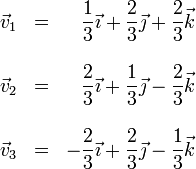1.12. Ejemplo de construcción de una base
De Laplace
(→Segundo vector) |
(→Segundo vector) |
||
| Línea 50: | Línea 50: | ||
<center><math>(\vec{a}\times\vec{v})\times \vec{v}=\left|\begin{matrix}\vec{\imath} & \vec{\jmath} & \vec{k} \\ 6 & -6 & 3 \\ 1 & 2 & 2 \end{matrix}\right|=-18\vec{\imath}-9\vec{\jmath}+18\vec{k}</math></center> | <center><math>(\vec{a}\times\vec{v})\times \vec{v}=\left|\begin{matrix}\vec{\imath} & \vec{\jmath} & \vec{k} \\ 6 & -6 & 3 \\ 1 & 2 & 2 \end{matrix}\right|=-18\vec{\imath}-9\vec{\jmath}+18\vec{k}</math></center> | ||
| - | Dividiendo por el módulo de \vec{v} al cuadrado y cambiando el signo obtenemos la componente normal | + | Dividiendo por el módulo de <math>\vec{v}</math> al cuadrado y cambiando el signo obtenemos la componente normal |
<center><math>\vec{a}_n = -\frac{(-18\vec{\imath}-9\vec{\jmath}+18\vec{k})}{9}=2\vec{\imath}+\vec{\jmath}-2\vec{k}</math></center> | <center><math>\vec{a}_n = -\frac{(-18\vec{\imath}-9\vec{\jmath}+18\vec{k})}{9}=2\vec{\imath}+\vec{\jmath}-2\vec{k}</math></center> | ||
Revisión de 16:03 7 sep 2010
Contenido |
1 Enunciado
Dados los vectores


Construya una base ortonormal dextrógira, tal que
- El primer vector vaya en la dirección de

- El segundo esté contenido en el plano definido por
 y
y 
- El tercero sea perpendicular a los dos anteriores, y orientado según la regla de la mano derecha.
2 Primer vector
Obtenemos el primer vector normalizando el vector  , esto es, hallando el unitario en su dirección y sentido, lo que se consigue dividiendo este vector por su módulo
, esto es, hallando el unitario en su dirección y sentido, lo que se consigue dividiendo este vector por su módulo

Hallamos el módulo de 

por lo que

3 Segundo vector
El segundo vector debe estar en el plano definido por  y
y  , por lo que debe ser una combinación lineal de ambos
, por lo que debe ser una combinación lineal de ambos

además debe ser ortogonal a  (y por tanto, a
(y por tanto, a  )
)

y debe ser unitario

El procedimiento sistemático consiste en hallar la componente de  normal a
normal a  y posteriormente normalizar el resultado.
y posteriormente normalizar el resultado.
La proyección normal la calculamos con ayuda del doble producto vectorial

Calculamos el primer producto vectorial

Hallamos el segundo

Dividiendo por el módulo de  al cuadrado y cambiando el signo obtenemos la componente normal
al cuadrado y cambiando el signo obtenemos la componente normal

Normalizando esta cantidad obtenemos el segundo vector de la base

4 Tercer vector
El tercer vector lo obtenemos como el producto vectorial de los dos primeros

Por tanto, la base ortonormal dextrógira está formada por los vectores






